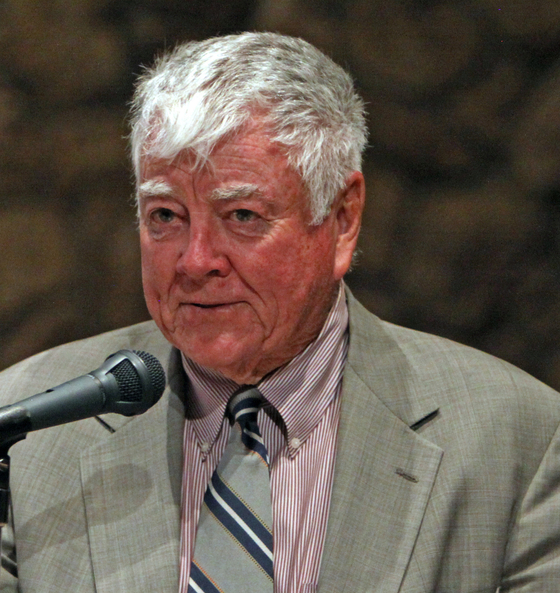전 연방의원, 한국전에 대한 미국 실책 5가지 사과
참전용사 피트 맥클로스키 전 의원, 한국에 사과

Pete McCloskey
“미국, 한국 분단에 5가지 책임”
한국전 참전용사인 피트 맥클로스키(94·민주) 전 연방하원의원이 미국이 한국 분단을 야기한 5가지 실책을 주장해 관심을 모은다.
맥클로스키 전 의원은 지난 25일 샌프란시스코에서 열린 한 행사에서 72주년을 맞은 6·25 관련 연설을 통해 “더글러스 맥아더 장군의 오만함과 부족한 정보력이 중국(중공)의 참전을 초래했고 이로 인해 한국이 통일의 기회를 놓친 것이 가장 뼈아픈 실책”이었다고 지적했다.
한국 전문가로도 널리 알려진 맥클로스키는 2014년 도널드 그렉 주한 미국대사 등과 함께 방북했으며 북한의 경제개발을 통해 한국과의 관계를 보다 밀접하게 만들어야 한다고 주장했다.
맥클로스키는 1945년 미 해군에 입대해 1950년~1952년 해병대에서 근무했고, 한국전과 월남전에 참전했다.
“중국 개입 부른 맥아더의 오만함 뼈아팠다”
“일본에게 한국 장악 기회
러시아 북한 점령 초래
한국군에 방어 무기만”
한국전 참전용사 출신인 피트 맥클로스키(94·민주.사진) 전 연방하원의원이 지난 주말 샌프란시스코에서 6.25 한국전쟁 72주년 관련 연설을 통해 미국이 한국 분단을 야기시킨 5가지 실책을 제시했다. 일종의 사과문 성격을 띠고 있어 관심을 모았다.
그는 “나의 이러한 생각을 윤상수 샌프란시스코 총영사에게 겸허한 마음으로 전달했다”며 “미국의 오점을 정확하게 짚고 있다고 본다”고 했다.
맥클로스키 전 의원은 미국의 첫 번째 실책이 1905년 테디 루즈벨트 대통령이 러시아를 견제하면서 한국을 일본에 넘긴 과정에서 비롯됐다고 지적했다. “루즈벨트는 러일전쟁 종식에 기여한 공로로 노벨 평화상을 수상했지만, 일본이 한국을 야만적으로 점령한 일을 간과했다”며 “일본은 한국을 발판으로 1931년 만주를 침공했다. 이어 중국 본토까지 공격했다”고 했다.
두 번째 실책으로 그는 얄타 회담 때 노쇠했던 프랭클린 루즈벨트 대통령이 서거 직전인 1945년 4월 독일이 항복했을 때, 러시아에 일본과의 전쟁을 종용한 점을 들었다. 이것이 러시아가 북한을 장악하는 일을 초래했다는 것이다. 그는 “당시 미국은 순진하게도 한국을 통일시킬 수 있을 것으로 여겼다”고 했다.
세 번째 실책으로 이승만 대통령이 호전적인 성향임을 우려해 미국이 한국에 수비형 무기만 안겨준 점을 지적했다. 이는 한국군이 김일성이 이끈 북한의 러시아제 T-34 탱크에 무방비 상태로 놓이게 했다는 것이다. 그는 “수많은 젊은 한국군이 T-34 탱크를 막지 못하고 전사했다”며 “북한은 T-34만으로 1950년 8월 한국 대부분을 점령할 정도였다”고 했다.
네 번째 실책으로 그는 1950년 1월 미국 국무장관(딘 애처슨)이 미국의 태평양 방어선에 한국은 포함되지 않았다고 선언한 점을 꼽았다. 이 같은 결정은 김일성에게 남침하라는 초대장이나 마찬가지였다고 했다. 그는 “당시 북한은 남한보다 훨씬 강력한 군사력과 무기가 있었다”고 했다. 그러면서 “해리 트루먼 대통령이 북한을 상대로 공격해야 한다고 UN에 촉구하는 용기 덕분에, 16개국이 1950년 9월 15일 인천상륙작전을 펼쳐 북한을 막고 남한을 구할 수 있었다”고 지적했다.
다섯 번째 실책으로 더글러스 맥아더 장군의 오만함과 부족한 정보력을 비판했다. 그는 가장 결정적인, 뼈아픈 실책이었다고 강조했다.
맥아더 장군에 대해 그는 “9월에 인천과 서울에서 엄청난 성공을 거뒀으나 이는 그에게 오만함을 심어줬다”며 “이후 맥아더는 중국 리더 마오쩌둥의 경고를 무시했다. 마오쩌둥은 미군이 38선을 넘어 한국과 중국 사이에 있는 압록강까지 침투하면 중국도 전쟁에 나설 것이라고 경고했던 터”라고 했다. 이어 “결국 중국이 전쟁에 참여하게 된 계기가 됐다. 만약 맥아더 장군이 한국군의 북한 점령으로 일을 끝냈다면 중국이 개입하지 않았을 것이다. 그리고 오늘날 한국은 통일돼 있었을 것”이라고 진단했다.
맥클로스키 전 의원은 과거 미국의 여러 실책으로 한국이 분단돼 북한과 서로를 향해 총을 겨누는 현실이 된 게 안타깝다면서 연설을 마무리했다.
※맥클로스키 의원은
1927년 캘리포니아주 로미린다 출생. 스탠포드 로스쿨 졸업. 해병대 멤버로 한국전에 참전해 네이비 크로스와 실버 스타 수상. 공화당원으로 1967년~1983년에 연방하원 활동. 1972년 월남 참전 반대 카드로 공화당 대선 경선 출마해 리처드 닉슨 대통령에 패배. 연방의회에서 닉슨 대통령 사임을 가장 먼저 촉구. 이라크전 반대하면서 2007년 탈당해 민주당에 입당.
현재 비영리단체 퍼시픽 센추리 학회(Pacific Century Institute) 이사.
정리=원용석 기자
다음은 연설문 전문.
Judge Quentin Kopp, to make a few remarks on this occasion. Because
physical infirmity may prevent me from speaking more than a few words, I
am taking the liberty of exercising a historic privilege given to Members of
Congress to “revise and extend” their remarks.
I’m particularly honored to be able to pay tribute to the late John Stevens,
Captain of one of the twelve understrength Marine rifle companies who are
credited with saving the Naktong Perimeter in August, 1950, and to the
Directors of the Presidio Trust, who made this Memorial possible. I would
also like to express thanks to the three Democrat Congressmen, Clem
Miller, Phil Burton, and John Burton, who caused the creation of the Point
Reyes National Seashore and Golden Gate Recreation Area.
John Stevens is the primary creator of this Memorial where we sit today,
and more than any other American, has well earned the enduring respect of
both the Korean and American people.
I’m particularly proud of the wisdom and generosity of the members of the
Board of the Presidio Trust for their decision to make this Memorial a part
of California’s long history.
I am even prouder of the progress the South Korean people have made
since 1950, establishing a robust economy and a democratic government
not dissimilar to our own.
I take note that the fact the California Republican Members of Congress
include two Korean Americans, one born at Inchon and one in Seoul,
Korea.
John Stevens’ and my battalion of the Fifth Marine Regiment landed at
Inchon on September 15th, 1950, and were successful in recapturing Seoul
on September 28, 1950.
I have long reflected on the similarity of California’s geography to that of
Korea’s, and the good fortune which we have enjoyed of having peace
here, since California became a state in 1850.
By comparison, South and North Korea suffered the loss of over two million
people during the three-year period of the Korean War, together with the
devastation of nearly all of their cities, villages and countryside during that
period.
I am not so proud, however, of five actions of United States’ leaders which
ultimately led to the terrible division of Korea which all Koreans suffer today.
I want to convey to Consul General Sangsoo Yoon my personal apology for
those five tragic mistakes.
Let me try to list them here.
1. In 1905, President Teddy Roosevelt was awarded the Nobel Peace
Prize for his leadership in negotiating the Portsmouth Treaty of 1905
between Japan and Russia. The Japanese Navy had virtually destroyed
the Russian Navy, and President Roosevelt acquiesced in awarding Korea
to the Japanese. The Japanese would thereafter cruelly occupy Korea, and
later use Korea as a base for the invasion of Manchuria in 1931, and, later
still, its invasion of mainland China. I doubt that President Roosevelt was
aware that Japan had long coveted control of Korea, and that some 300
years earlier, between 1592-1598, the weak Ming dynasty in China had
permitted Koreans to have what amounted to their own independent
government. A Japanese warlord had invaded Korea with 300,000 men but
was ultimately driven out by the famous Korean Admiral Yi Sun-sin using
the famous “turtle ships” to defeat the Japanese in sixteen separate naval
battles.
2. The second great mistake was at Yalta in February, 1945, when an
ailing President Franklin D. Roosevelt, shortly before his death,
encouraged Russia to agree to enter the war against Japan, following the
surrender of Germany, which followed in April, 1945.
American Army officers and diplomats were authorized to divide Korea at
the 38th Parallel, to permit the Russians to occupy North Korea with its
population of roughly ten million, while the United States would install a
democratic form of government for the twenty million Koreans living south
of the Parallel.
In our naivete, we expected the country to be subsequently united by some
sort of plebiscite.
3. Fearful, however, that the militant South Korean President Syngman
Rhee would invade North Korea if he were furnished offensive weapons
including tanks and artillery, the U.S. limited arms to the South Koreans to
defensive weapons, which were incapable of stopping the Russian-built
T-34 tanks which Russia furnished Kim Il-sung, the seasoned military
leader who had successfully fought the Japanese in Manchuria. A lot of
brave young South Korean soldiers would die attempting unsuccessfully to
stop those T-34 tanks, which nearly overran all of South Korea in August
1950.
4. In January, 1950, the American Secretary of State announced that South
Korea was not within the American “defense perimeter” in the Pacific. This
was a virtual invitation to Kim Il-sung to attempt to reunify Korea, with his
vastly superior army and weaponry.
Only the courage of President Harry Truman in seeking and obtaining
immediate United Nations action against North Korea, and the participation
of sixteen other nations in ultimately stopping the North Korean advance by
the landing at Inchon on September 15, 1950, saved South Korea.
5. Perhaps the most significant error was through the arrogance and lack of
good intelligence on the part of General Douglas MacArthur, who, after his
smashing September victories at Inchon and Seoul, led him to ignore the
clear warning of the China’s leader, Mao Tse Tung, that if American troops
crossed the 38th Parallel and moved to the Yalu river border between
Korea and China, China would enter the war.
Had MacArthur limited the reoccupation of North Korea only by the
resuscitated South Korean army divisions, it is entirely possible that China
would not have entered the war, and Korea would be a united, single nation
today. I tender these thoughts to Consul General Sangsoo Yoon with some
humility and sadness, but believe they accurately reflect the mistakes of an
otherwise great nation, my own.
So much for the history of a war that might not have necessarily been
fought.
A Geographical Comparison Between Korea and California
From a geographic standpoint, we should not forget that the 38th Parallel,
crossed by John Stevens’s Marines three times and thrown back across
the Parallel twice, runs through some of California’s most beautiful
landscape, starting a few miles north of here at Point Reyes and extending
from San Rafael on the north across through Stockton, the Tioga Pass and
Yosemite National Park to Mono Lake on the east side of the Sierras.
The Presidio Trust has quietly appreciated and preserved the history that
for many years, a few hundred yards west of this spot, our Coast Artillery
mounted batteries of 16-inch guns to defend against potential battleships of
the Japanese Navy. Luckily those 16-inch guns were never fired at an
enemy, and the guns were scrapped, to be replaced by flower beds after
the end of WWII.
I well remember, at the age of 11, marveling at the historical pageants at
the 1939 World’s Fair at Treasure Island, but also marveling at the huge 16-
inch “disappearing guns” mounted at the Presidio.
Neither John Stevens nor I were involved in the retreat from the Chosin
Reservoir in December 1950, when 16-inch shells weighing nearly a ton
were fired by the battleship Missouri at the several Chinese divisions which
were attempting to block the retreat of the Marines from the Chosin
Reservoir.
One young veteran of that retreat later told me of the incredible terror
caused by one 16-inch shell fired by the battleship Missouri which burst a
few hundred yards away, literally disintegrating a group of nearly frozen
Chinese infantrymen.
It remains a sobering fact for reflection by those of us here today on a
peaceful Saturday, to reflect that the many millions of South Koreans living
in Seoul and its environs, are faced with hundreds of North Korean artillery
pieces positioned across the present demilitarized zone, capable of
reducing the South Korean capitol of Seoul to the same kind of destruction
our atom bombs and fire bombing once caused to Hiroshima, Nagasaki
and Tokyo.
With thermonuclear weapons in the hands of men who may be close to
being mentally unstable, we can never be sure that even the beautiful San
Francisco Bay Area and this Presidio will remain safe from some madman’s
decision to attack and destroy us with thermonuclear weapons.
Against that sobering thought, I want to add one personal note, which may
be of interest to Consul General Sangsoo Yoon.
Some forty years after I had served in Korea, in 1992, I wrote a book
mentioning that, in retrospect, we Americans had to admire the courage of
the young Chinese and North Koreans against whom we had fought in
close combat with rifles, grenades, and machine guns in Korea.
Eight years ago, in 2014, I was invited to join a delegation headed by
former U.S. Ambassador to Korea Donald Gregg to accompany a small
group of businessmen to Pyongyang to offer advice to North Korean
businessmen regarding economic development that might bring North and
South Korea closer together.
When we arrived in the North Korean capitol, I asked if there were any
surviving North Korean soldiers from the spring of 1951. The North
Koreans produced a retired Lieutenant General, Ji Young Choon, who, at
the age of 17, had led a machine gun platoon in the fighting around Inje
and Yanggu on the 38th Parallel. He was serving as a docent at the North
Korean Military Museum. We learned through an interpreter that each of us
had been wounded twice in the bitter fighting in May and June on the steep
north-south ridge lines leading up to the famous “Punchbowl.”
The late Eddie LeBaron, one of the Korean War Memorial Foundation’s
original directors, was also wounded in that fighting as a Marine rifle
platoon leader.
At the end of two days, General Ji and I ended up embracing and saluting
each other, and agreed that there was no glory in war and that we hoped
that our grandchildren and great-grandchildren would never fight against
each other. Now, 8 years later, I have a 31-year-old grandson teaching
English to Korean school children in Taegu, a few miles south of Wonju,
from which John Stevens’s company and mine led the first counter-attack
against the Chinese on February 21, 1951.
I have to assume, regrettably, that General Ji’s grandsons have been
drafted into the North Korea army and taught to hate both Americans and
South Koreans.
Nevertheless, I am led to hope that in the eight years since General Ji and I
met in Pyongyang there has been some progress behind the scenes to
ultimately allow the North and South Koreans to reach a reconciliation,
rather than continue the terribly unproductive pursuit of the development of
huge weapons such as the 16-inch guns once mounted to the west of this
Monument. In our youth, we fought on both sides in the belief that our
respective causes were just. As we age, however, we look for leaders with
the wisdom to know that wars are stupid and accept the words of Lincoln’s
famous Second Inaugural Address: “With malice toward none; with charity
for all.”
For the Foundation’s records, I have taken the liberty of attaching the Los
Angeles Times article and several photographs of the meeting between
myself and the former young North Korean machine-gunner, Ji Young
Choon.
If John Stevens were alive today, I believe he would join me, Judge Kopp,
Presidio Trustee Mark Buell, and Consul General Sangsoo Yoon, in the
hope that our great grandchildren will someday see a peaceful reunification
of the Korean people.
Respectfully,
Paul N. “Pete” McCloskey, Jr










with the Korea JoongAng Daily
To write comments, please log in to one of the accounts.
Standards Board Policy (0/250자)